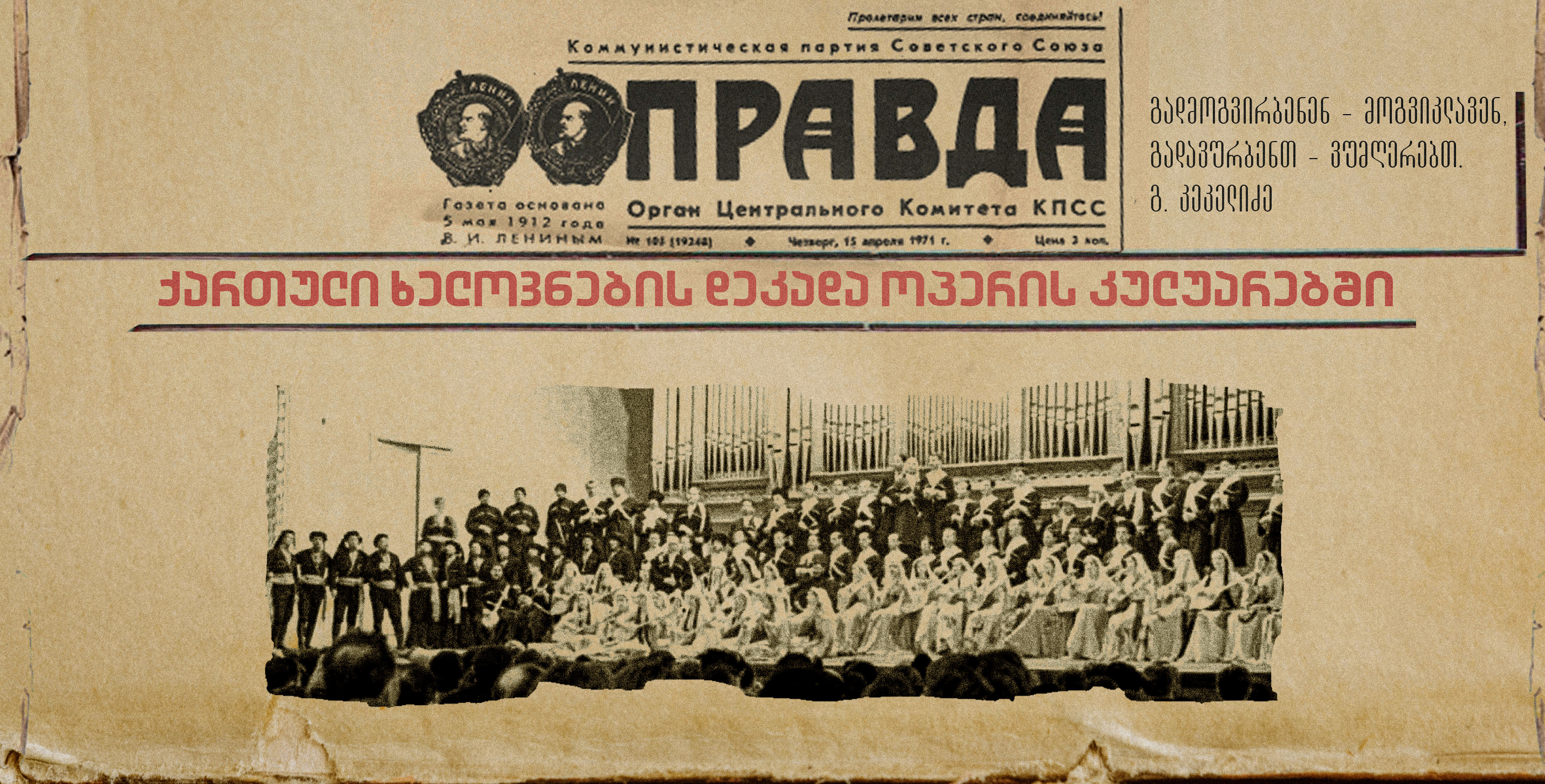The Story of a Great Chanter: Davit Shotadze, a.k.a. Chkhareli
One of the oldest and most remarkable secular buildings in Kutaisi is the Okros Chardakhi, known in English as the Golden Canopy or Golden Marquee. It was the residence of the kings of Imereti and was declared in 2006 a monument of immovable cultural heritage of national importance.. In the same building complex was the Royal Palace Church, where, archival records tell us, the best chanters of the old times sang during the reign of Solomon II (1789–1810), the last king of Imereti...

Okros Chardakhi (The Golden Marquee) (photo from National library of Georgia)
One of those chanters was Davit Shotadze, widely known as Davit Chkhareli. Following the abolition of the autocephaly of the Georgian Church, synodal cantors were established in Western and Eastern Georgia to register individuals working in churches. According to the sources from the Naitonal Archives of Georgia, “During the king’s reign, he was a chanter at the king’s court, and was appointed as a chanter of the Kutaisi Cathedral,” likely in 1821.[1]
Davit Shotadze, son of Iese, was born in 1768 in the Chkhari township in the Terjola district. He received his theological education at the Gelati monastery and studied chanting there. As Razhden Khundadze wrote in the early twentieth century, “Gelati used to be the nest of chanting. As we know, many of our famous chanters who have passed away—Anton Dumbadze, Sino Kandelaki, Davit Chkhareli (Shotadze)—and other outstanding chanters all came up in Gelati.”[2] Davit Shotadze’s surname also appears in some records as Dekanozishvili, perhaps because his father Iese was a deacon. (Dek’anozi means “deacon” in Georgian.)
After the kingdom of Imereti was abolished in 1810, one new diocese of Imereti was created out of the four existing dioceses (Kutaisi, Gelati, Khoni, and Nikortsminda) and, as in Russia, church staff limitations were established for the chanters:
In Kutaisi Cathedral there were five staffs positions; in Gelati monastery there was one, which was subsequently canceled, as well. The imposition of these staff limits threw the singers, who were already reduced by the black plague and natural disasters of 1810–1812, into an even worse situation.[3]
Alongside Davit Shotadze, the most accomplished generation of the famous Kandelaki family of Imeretian chanters, Okropiri and Simon Kandelaki, were also chanting at the court chapel and in the cathedral. A contemporary observer said this regarding Simon Kandelaki’s chanting expertise, reporting Kandelaki’s own admiration for Shotadze:
[Simon Kandelaki] is the best chanter in Imereti, Guria, and Samegrelo [...] But the honorable man himself says: “Davit Chkhareli (his last name was Shotadze, a wonderful singer from lower Chkhari) took twenty ch’reli [i.e., “ornamented”] chants to the grave with him, and we the living are left without them.”[4]

Archbishop Mose Bogdanov-Platonovi 1832-1834 (photo from Wikipedia)
In 1833, an unprecedented event took place, unlike anything before or since. At that time, Mose Bogdanov-Platonovi (1832–1834) was the Exarch of the Church of Georgia. Unlike his predecessors, he was not completely indifferent to Georgian church chanting. Moreover, he wrote a letter to the head of the diocese of Imereti, Archbishop Sofron, asking to send the region’s best singersto Tbilisi, because he wanted to preserve in writing the old church hymns of Imereti:
As this can only take place in person [the exarch wrote], I respectfully ask Your Highness to send me, after the Holy Passover, three men from among your chanters, well-versed in Imeretian church chanting, who could come to Tbilisi for five or six days and return to you after.[5]
Archbishop Sofron chose four singers, instead of three, to be sent to Tbilisi: Okropir Kandelaki, Simon Kandelaki, Davit Shotadze and a priest known as Svimon. A few days later, Exarch Mose sent the singers back with great satisfaction and a letter of gratitude.
Davit Shotadze was known not only as a performer of chants, but also as a mentor and teacher for many prominent singers, including Okropiri, Kandelaki, Ivane, Kandelaki, and his own son Giorgi, also known as Gogina Shotadze. Like his father, Gogina became a prominent singer himself and chanted at the cathedral in Kutaisi. The writer Akaki Tsereteli, in his memoirs of childhood, attests to Gogina’s mastery, describing a performance by two choirs consisting of experienced and well-known Gurian and Imeretian chanters:
The ringing of the bells grew more frequent and called the priest from the station. He came out and greeted the congregation with holy water and incense, while chanters from both regions were led up to the church. One group was made up of Imeretians: Okropir Kandelaki, Gogina Shotadze, and Sino [i.e., Simon] Kandelaki; the other group, the Gurians, consisted of Data Gugunava, Karaman Tavdgiridze, and Anton Dumbadze. The Kandelakis’ side was performing sada [unornamented] chants and the Gurians were singing k’rimanch’uli [yodeling]. The people were captivated by their performance, but they split into two sides: half liked the Gurians better, and half liked the Imeretians. The younger people were leaning more towards the Gurians; the older people said “No! The Kandelakis are one thing, and isn’t the Gurian k’rimanch’uli another? It’s true that they have grown old, their voices have become thinner, and the Gurians are young, they are loud and sing in k’ilo [i.e., in the right style], but ... but it’s still something completely different!”[6]
After thirty-four dedicated years, on July 4, 1845, Davit Shotadze was released from his service at the cathedral:
On July 4 of the present year, due to old age and inability to continue his service, Davit Shotadze, the chanter of the Kutaisi Cathedral, is hereby relieved him from his position, and on the first day of May of the next year, Besarion Kandelaki, son of Okropiri, will begin his appointment as cantor in his stead.[7]
Unfortunately, we do not know and have not yet been able to find out exactly in what year he died and where this accomplished singer is buried. The archives preserve the history of a number of skilled but little-known singers, whose introduction to the general public is important. In future issues we will continue to offer you more of these materials, many of which will be published for the first time.
[1]National Archives of Georgia, Central Historical Archive, fond No. 489 sak. 6304 (1838)
[2] Razhden Khundadze, “Kartuli galoba: ra mdgomareobashi iqo kartuli galoba, ts’inat da ra mdgomareobashia dghes” (Georgian chanting: The state of Georgian chanting then and now) Shinauri sakmeebi, May 9, 1910 (no. 18), 10.
[3] Merab Kezevadze, Dok’ument’ebi imeretshi saek’lesio galobis ist’oriistvis (Documents on the history of church chanting in Imereti) (Kutaisi: Sagamomtsemlo tsent’ri, 2006), 8–9.
[4] L. Iverieli, “Kartuls galobaze” (On Georgian chanting), Iveria, September 28, 1878 (no. 38), 8.
[5]Kezevadze, Dok’ument’ebi, 10.
[6] Akaki Tsereteli, “Mogoneba (pekhta bana)” (Memories [the footbath]), K’vali, July 3, 1894 (no. 28), 4.
[7] Kutaisi Central State Archive, fond No. mm-21, sak. 3327.


.jpg)

